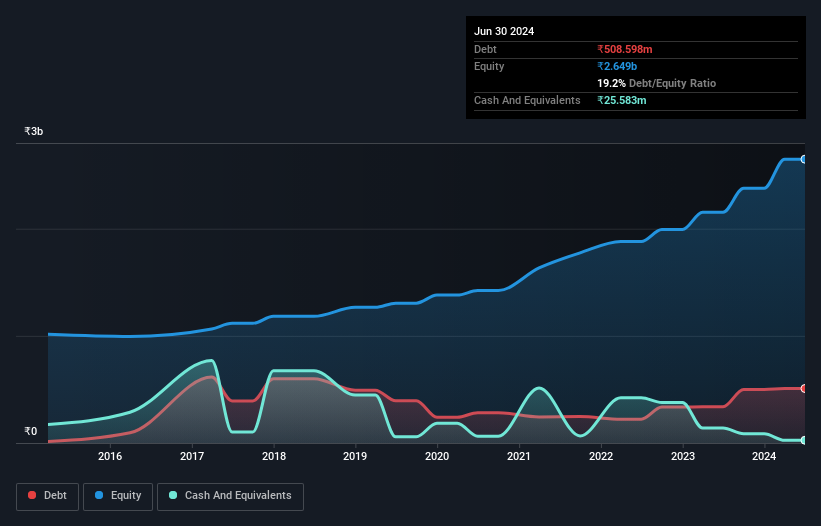- India
- /
- Specialty Stores
- /
- NSEI:RADHIKAJWE
Radhika Jeweltech (NSE:RADHIKAJWE) Has A Pretty Healthy Balance Sheet
The external fund manager backed by Berkshire Hathaway's Charlie Munger, Li Lu, makes no bones about it when he says 'The biggest investment risk is not the volatility of prices, but whether you will suffer a permanent loss of capital.' So it seems the smart money knows that debt - which is usually involved in bankruptcies - is a very important factor, when you assess how risky a company is. Importantly, Radhika Jeweltech Limited (NSE:RADHIKAJWE) does carry debt. But is this debt a concern to shareholders?
What Risk Does Debt Bring?
Debt is a tool to help businesses grow, but if a business is incapable of paying off its lenders, then it exists at their mercy. Part and parcel of capitalism is the process of 'creative destruction' where failed businesses are mercilessly liquidated by their bankers. However, a more common (but still painful) scenario is that it has to raise new equity capital at a low price, thus permanently diluting shareholders. Of course, debt can be an important tool in businesses, particularly capital heavy businesses. When we think about a company's use of debt, we first look at cash and debt together.
Check out our latest analysis for Radhika Jeweltech
How Much Debt Does Radhika Jeweltech Carry?
You can click the graphic below for the historical numbers, but it shows that as of March 2024 Radhika Jeweltech had ₹508.6m of debt, an increase on ₹338.0m, over one year. On the flip side, it has ₹25.6m in cash leading to net debt of about ₹483.0m.

How Healthy Is Radhika Jeweltech's Balance Sheet?
The latest balance sheet data shows that Radhika Jeweltech had liabilities of ₹459.9m due within a year, and liabilities of ₹101.2m falling due after that. Offsetting this, it had ₹25.6m in cash and ₹7.28m in receivables that were due within 12 months. So its liabilities total ₹528.2m more than the combination of its cash and short-term receivables.
Of course, Radhika Jeweltech has a market capitalization of ₹13.7b, so these liabilities are probably manageable. Having said that, it's clear that we should continue to monitor its balance sheet, lest it change for the worse.
In order to size up a company's debt relative to its earnings, we calculate its net debt divided by its earnings before interest, tax, depreciation, and amortization (EBITDA) and its earnings before interest and tax (EBIT) divided by its interest expense (its interest cover). The advantage of this approach is that we take into account both the absolute quantum of debt (with net debt to EBITDA) and the actual interest expenses associated with that debt (with its interest cover ratio).
Radhika Jeweltech has a low net debt to EBITDA ratio of only 0.69. And its EBIT covers its interest expense a whopping 22.9 times over. So you could argue it is no more threatened by its debt than an elephant is by a mouse. On top of that, Radhika Jeweltech grew its EBIT by 51% over the last twelve months, and that growth will make it easier to handle its debt. When analysing debt levels, the balance sheet is the obvious place to start. But it is Radhika Jeweltech's earnings that will influence how the balance sheet holds up in the future. So when considering debt, it's definitely worth looking at the earnings trend. Click here for an interactive snapshot.
Finally, while the tax-man may adore accounting profits, lenders only accept cold hard cash. So we clearly need to look at whether that EBIT is leading to corresponding free cash flow. Over the last three years, Radhika Jeweltech saw substantial negative free cash flow, in total. While that may be a result of expenditure for growth, it does make the debt far more risky.
Our View
Radhika Jeweltech's interest cover suggests it can handle its debt as easily as Cristiano Ronaldo could score a goal against an under 14's goalkeeper. But the stark truth is that we are concerned by its conversion of EBIT to free cash flow. All these things considered, it appears that Radhika Jeweltech can comfortably handle its current debt levels. On the plus side, this leverage can boost shareholder returns, but the potential downside is more risk of loss, so it's worth monitoring the balance sheet. There's no doubt that we learn most about debt from the balance sheet. But ultimately, every company can contain risks that exist outside of the balance sheet. For example, we've discovered 1 warning sign for Radhika Jeweltech that you should be aware of before investing here.
Of course, if you're the type of investor who prefers buying stocks without the burden of debt, then don't hesitate to discover our exclusive list of net cash growth stocks, today.
New: AI Stock Screener & Alerts
Our new AI Stock Screener scans the market every day to uncover opportunities.
• Dividend Powerhouses (3%+ Yield)
• Undervalued Small Caps with Insider Buying
• High growth Tech and AI Companies
Or build your own from over 50 metrics.
Have feedback on this article? Concerned about the content? Get in touch with us directly. Alternatively, email editorial-team (at) simplywallst.com.
This article by Simply Wall St is general in nature. We provide commentary based on historical data and analyst forecasts only using an unbiased methodology and our articles are not intended to be financial advice. It does not constitute a recommendation to buy or sell any stock, and does not take account of your objectives, or your financial situation. We aim to bring you long-term focused analysis driven by fundamental data. Note that our analysis may not factor in the latest price-sensitive company announcements or qualitative material. Simply Wall St has no position in any stocks mentioned.
About NSEI:RADHIKAJWE
Radhika Jeweltech
Engages in the manufacture and retail of jewelry in India.
Outstanding track record with flawless balance sheet.
Similar Companies
Market Insights
Community Narratives




